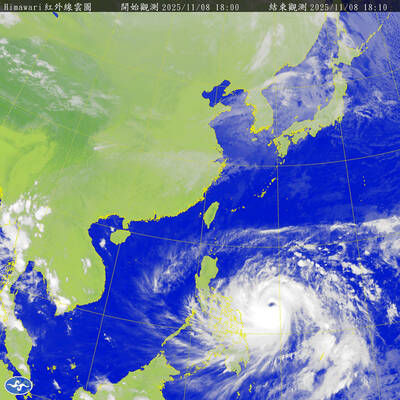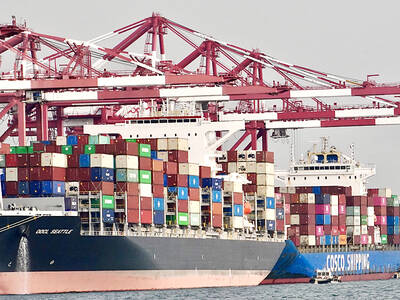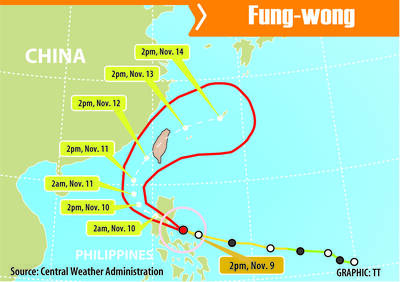Apple Inc is planning to use an updated version of Taiwan Semiconductor Manufacturing Co’s (TSMC, 台積電) latest chip production technology for iPhones and Macbooks next year, the Nikkei Asia reported yesterday.
The A17 mobile processor, which is under development, would be mass produced using TSMC’s 3-nanometer enhanced (N3E) process technology, expected to be available in the second half of next year, the newspaper said, citing people familiar with the matter.
The A17 would be used in the premium model of the iPhone lineup slated for release next year, it said.

Photo: Bloomberg
Apple declined to comment, while TSMC did not immediately respond to a Reuters request for a comment.
Current iPhone models use the A15 processor, while the iPhone 14 Pro, which was released last week, features the same chip.
TSMC has a 54 percent share in the global market for contractually produced chips, supplying Apple, Qualcomm Inc and other firms.
TSMC said the development of its high-end process has been proceeding smoothly and commercial 3-nanometer production is to start later this year, a year ahead of the launch of N3E.
The 3-nanometer process started a trial run last year, with the firm’s 5-nanometer process the latest to enter mass production.
TSMC’s 3-nanometer family uses FinField-effect-transistor technology, a 3D transistor structure that enables chips to run faster using the same amount of power or to run at the same speed on reduced power.
Late last month, TSMC chief executive officer C.C. Wei (魏哲家) said that the company had encountered many difficulties in developing the 3-nanometer process, but would soon begin mass production with many of its customers keen to work with it.
Meanwhile, TSMC plans to mass produce chips using the more sophisticated 2-nanometer process in 2025 at a wafer plant to be built at the Hsinchu Science Park (新竹科學園區).
The 2-nanometer process would become the first technology in which TSMC employs a gate-all-around structure, which reduces undesirable variability and mobility loss, making the technology the most competitive and efficient on the market.
Wei has touted the company’s 2-nanometer process as the industry’s best and most efficient technology when mass production begins.

The Central Weather Administration (CWA) yesterday said it expected to issue a sea warning for Typhoon Fung-Wong tomorrow, which it said would possibly make landfall near central Taiwan. As of 2am yesterday, Fung-Wong was about 1,760km southeast of Oluanpi (鵝鑾鼻), Taiwan’s southernmost point, moving west-northwest at 26kph. It is forecast to reach Luzon in the northern Philippines by tomorrow, the CWA said. After entering the South China Sea, Typhoon Fung-Wong is likely to turn northward toward Taiwan, CWA forecaster Chang Chun-yao (張峻堯) said, adding that it would likely make landfall near central Taiwan. The CWA expects to issue a land

Taiwan’s exports soared to an all-time high of US$61.8 billion last month, surging 49.7 percent from a year earlier, as the global frenzy for artificial intelligence (AI) applications and new consumer electronics powered shipments of high-tech goods, the Ministry of Finance said yesterday. It was the first time exports had exceeded the US$60 billion mark, fueled by the global boom in AI development that has significantly boosted Taiwanese companies across the international supply chain, Department of Statistics Director-General Beatrice Tsai (蔡美娜) told a media briefing. “There is a consensus among major AI players that the upcycle is still in its early stage,”

The Central Weather Administration (CWA) yesterday said it is expected to issue a sea warning for Typhoon Fung-wong this afternoon and a land warning tomorrow. As of 1pm, the storm was about 1,070km southeast of Oluanpi (鵝鑾鼻), Taiwan’s southernmost point, and was moving west-northwest at 28 to 32kph, according to CWA data. The storm had a radius of 250km, with maximum sustained winds of 173kph and gusts reaching 209kph, the CWA added. The storm is forecast to pass near Luzon in the Philippines before entering the South China Sea and potentially turning northward toward Taiwan, the CWA said. CWA forecaster Chang Chun-yao (張峻堯) said

‘SECRETS’: While saying China would not attack during his presidency, Donald Trump declined to say how Washington would respond if Beijing were to take military action US President Donald Trump said that China would not take military action against Taiwan while he is president, as the Chinese leaders “know the consequences.” Trump made the statement during an interview on CBS’ 60 Minutes program that aired on Sunday, a few days after his meeting with Chinese President Xi Jinping (習近平) in South Korea. “He [Xi] has openly said, and his people have openly said at meetings, ‘we would never do anything while President Trump is president,’ because they know the consequences,” Trump said in the interview. However, he repeatedly declined to say exactly how Washington would respond in